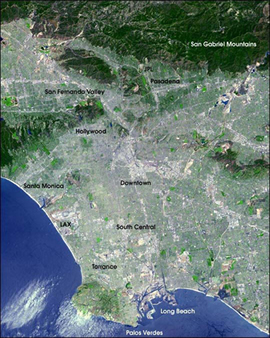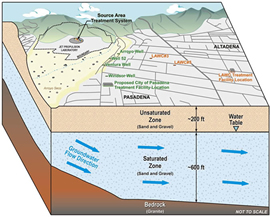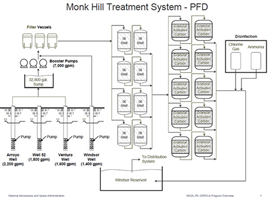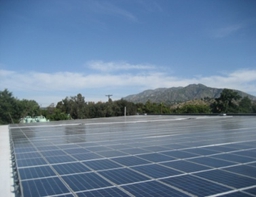Green Remediation Focus
NASA Jet Propulsion Laboratory (JPL)
Pasadena, California
Federal Facility, Superfund NPL
Cleanup Objectives: Treat groundwater and soil through (1) on-facility soil vapor extraction to remove volatile organic compounds (VOCs) in the source area soil, (2) on-facility extraction, treatment, and reinjection to treat VOCs and perchlorate in source area groundwater, and (3) pumping of groundwater to an existing onsite treatment plant and a new off-facility municipal treatment plant for removal of residual VOCs and perchlorate
Green Remediation Strategy: Optimize pumping operations and treatment processes to be used by the off-facility municipal plant (funded by NASA) and implement green construction techniques for the plant through a partnership with the City of Pasadena
- Collaborate with the City of Pasadena during the project's conceptual design phase, which allowed sufficient time to incorporate green strategies into design and construction
- Offer a 1% contractor incentive for efforts supporting greening goals of Executive Order 13423
- Use Leadership in Energy and Environmental Design (LEED) construction criteria to plan stormwater management, outdoor lighting, waste management, materials reuse/recycling, and environmentally friendly material purchasing
- Modify pumping configurations to reduce elevation changes and pipeline friction along the water transfer corridor between the production wells and the proposed water treatment facility
- Optimize the proposed treatment system (liquid-phase granular activated carbon, ion exchange, filtration, and disinfection units) by negotiating with the water treatment vendor to remove post-filtration cartridge filters
- Evaluate renewable energy options for the existing, co-located Windsor Reservoir facility owned by Pasadena Water and Power, including (1) an in-line micro-hydro turbine system for the pressure-reducing station and (2) a photovoltaic (PV) system
- Evaluate more opportunities for reducing water intensity of well operations/flushing and treatment unit backwash, taking into account the high economic value of Los Angeles Basin water
- Coordinate with Pasadena Water and Power to optimize decision-making regarding options such as a power purchase agreement, green power purchasing, peak shaving, peak shifting, and emergency power for the co-located facilities
Results:
- Reduced the proposed water treatment system's pressure head as a result of optimization, which allowed integration of smaller pumps with lower energy demands
- Reduced capital costs for the new municipal water treatment plant by $400,000 due to elimination of the original water treatment process involving post-filtration cartridge filters
- Avoided $50,000/year and 330,000 pounds/year of greenhouse gas emissions due to reconfigured pumping and optimization, when compared to the original construction plan
- Recycled 95% of the waste generated during construction of the municipal treatment plant, including 744 tons of rock, 48 tons of concrete, 8 tons of steel, and 5 tons of mixed debris
- Used native, drought-tolerant plant species to landscape the new treatment plant, which included perimeter trees serving as a visual and noise buffer between the facility and nearby residences
- [City of Pasadena] Began operating the new plant (known as the Monk Hill Transfer Station) at a location in the approximate center of the contaminated groundwater plume; since October 2011 startup, the plant has treated groundwater at a rate reaching 7,000 gallons per minute
- Treating the plant wastewater (generated from periodic flushing and backwashing) and discharging it to an onsite spreading basin rather than discharging untreated wastewater to the sanitary sewer; this results in an estimated aquifer recharge of nearly 100 acre-feet each year
- [City of Pasadena] Completed installation of a 564 kW roof-top PV system in May 2011 at the Windsor Reservoir facility adjacent to the Monk Hill Transfer Station; under a 20-year power purchase agreement, the PV system is expected to annually generate 869,158 kWh of energy (approximately 20% of the treatment system's electricity consumption, or the equivalent power used by 100 to 125 average Pasadena homes)
- Contributing to sustainable environmental stewardship of the Los Angeles Basin, which suffers from VOC and perchlorate contamination caused by multiple sources
Property End Use: Ongoing missions of the National Aeronautics and Space Administration
Point of Contact: Steven Slaten, NASA
Update: January 2012













